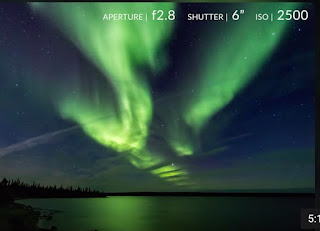notes on youtubes:
1) Lenses I wish I had never bought.
https://www.youtube.com/watch?v=Pgtat9ujhwY
24mm f1.4 sigma - the distortion too great for portraits. Image quality good, though. Misses focus at times.
Sounds like it might be good for me. I may want this instead of the Rokinon.
Samyang 24mm f3.5 - cheaper than above.
"tilt shift" lens?? this is a shift lens. The manual focus is an issue
2) Reduce high-ISO grain.
https://www.youtube.com/watch?v=GmV4heJ75Zg&frags=pl%2Cwn
shutter 20 seconds f/2.8
can't see anything until get too ISO 800
Loads RAW images into Photoshop. increasing exposure in PS results in SAME image as if you used the increased ISO.
Lesson - you get nothing more by increasing ISO IF you have an ISO invariant sensor. Which is mine? He discusses more on peterzelinka.com. Complete video on night photography there. Also backpack review
fixing in photoshop. Use RAW. The ONLY way to reduce grain is to capture more light. Can increase aperture, or increase shutter speed. USE a star tracker. But you do it in PS
1) increase luminance, don't go above 30
2) Nik collection (google) - processing software. Can automatically reduce noise.
3) PS software - filter-sharpen-smart sharpen. Set sharpen to zero, and adjust noise reduction.
4) multiple images and do median stack blend. Can't use a wide angle lens, do to distortion. Can at least do this for the foreground.
https://www.youtube.com/watch?v=tDgMXAW7jGI&frags=pl%2Cwn
iOptron Skytracker pro
If using a 14mm, precise alignment not critical
attach ball head to mounting plate on iOptron. Must have
set latitude on side device.
precise alignment: thumb screws on base
insert polar scope (vixen polarity does not have scope.) Other iOptron device has a central scope.
use polar finder app to show where Polaris should be in the scope.
has a counter weight
may not be able to do a big lens. Try sky guider pro.
he does the balancing by trial and error, but it seems easy to me to do with the bar off the motor.
Long exposure noise reduction on the D750: https://www.peterzelinka.com/blog/2018/5/nikon-d750-service-advisory---long-exposure-noise-reduction
(This is a way to do dark frame subtraction in camera !!!!!)
Review of several Astrophotography lenses:
https://www.peterzelinka.com/blog/2017/6/nikon-tamron-or-rokinon---best-lens-for-astro
how to do dark frame subtraction
https://www.peterzelinka.com/blog/2017/6/nikon-tamron-or-rokinon---best-lens-for-astro
how to shoot the milky way
https://www.peterzelinka.com/astrophotography
- ISO 3200
- Proper Shutter Speed ("200" Rule works well here)
- Wide open aperture (f/1.4, f/1.8/, f/2.8)
- Manual Focus set
- Long Exposure Noise Reduction OFF
white balance
3) HOW TO PHOTOGRAPH THE NORTHERN LIGHTS John Marriott
https://www.youtube.com/watch?v=YIAtlHdqM0Y&index=13&list=FLOVTBC1dxeb1rybZQiPCyjA&t=45s
Comment - I might increase aperture to 2.0 and decrease ISO to 3000
BUT - this is a very nice photo. could also incurs the time some. He does a nice time lapse.
2 second interval, 6 second exposure
110 shots - 10 minutes to shoot, 5 seconds of video
4) northern lights photography tutorial - 6 tips
https://www.youtube.com/watch?v=w7C7tBoB1d0&t=0s&index=11&list=FLOVTBC1dxeb1rybZQiPCyjA
Matt Granger - he did this in Iceland
Focuses on time lapse.
1) charge and prep. (can I use an external battery pack)
2) uses 1200 photos - D850 in raw 80-100 gB data
3) shoot wider than usual, to allow cropping.
4) lock exposure.
ISO 1600 f/2.8 5 seconds - Note that the foreground is faint.
Likes to shoot at 5 seconds maximum to see the motion.
He is using INTERVAL SHOOTING, Not time lapse
He locks mirror up.
HE shot 1200 images in Raw. Edited one, copied settings to all, batch export. put into movie at 25 frames/second.
How did he create a movie?
Music nice -from sound stripe
From comments - remove lens filters.
5) Phtographing the Aurora? keep this in mind
https://www.youtube.com/watch?v=DjVjghqTptw&t=0s&list=FLOVTBC1dxeb1rybZQiPCyjA&index=9
Jonathan Stewart
viewing is tricky - use aurora forecast.
get and warmers and attach to the camera.
cover and insulate camera.
bag the camera. to prevent fog.
ISO/shutter speed balance - ISO 2000 and 6 sec shutter.
Time lapse interval - shorter interval smooths motion, and increase the length of the video.
battery life - is there a battery backup for my camera?
for Sony - can do a batch edit of stills and then output movie.
6) photographing the northern lights
https://www.youtube.com/watch?v=4h8XjGECaAk
She works for sharp stars
batteries - keeps warm batteries in pockets
shutter speed slow:
2.5 seconds. Lights were bright that night. more texture in lights.
The interviewer feels that the noise reduction in LR works well.
6) Photographing the northern lights.
https://www.youtube.com/watch?v=JIRBlNDOPlE&frags=pl%2Cwn
https://www.youtube.com/watch?v=hHcoLnAiVOk&frags=pl%2Cwn
may need a remote shutter release if only because touching the release with gloves is tough.
if really cold, can get ice on lens.
warm up camera slowly.
tripod will get cold, joints may lock.
7)Focusing in the dark
https://www.youtube.com/watch?v=P5UIgOwReMQ&frags=pl%2Cwn
use wide aperture to allow live view to work in dark
manual focus mode
use headlamp to light foreground to help focus
tape to lens to lock
use live view
focus on a light in the distance
can shoot one photo focused to the foreground, one to stars, and combine






Comments
Post a Comment